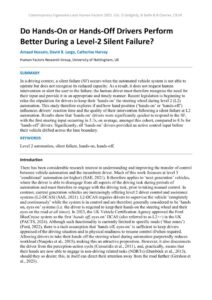| Document | Author Amaad Hussain, David R. Large, Catherine Harvey |
| Abstract In a driving context, a silent failure (SF) occurs when the automated vehicle system is not able to operate but does not recognise its reduced capacity. As a result, it does not request human intervention or alert the user to the failure; the human driver must therefore recognise the need for their input and provide it in an appropriate and timely manner. Recent legislation is beginning to relax the stipulation for drivers to keep their ‘hands-on’ the steering wheel during level 2 (L2) automation. This study therefore explores if and how hand position (‘hands-on’ or ‘hands-off’) influences drivers’ reaction time and the quality of their intervention following a silent failure at L2 automation. Results show that ‘hands-on’ drivers were significantly quicker to respond to the SF, with the first steering input occurring in 3.7s, on average, amongst this cohort, compared to 8.5s for ‘hands-off’ drivers. Significantly, all ‘hands-on’ drivers provided an active control input before their vehicle drifted across the lane boundary. |

